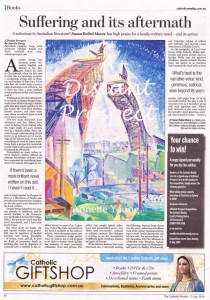A milestone in Australian literature? Susan Reibel Moore has high praise for a locally-written novel – and its author. (Click for printable PDF version)
(Credit: Annals Australasia and The Catholic Weekly.)
“if there has been
a more brilliant novel
produced on this soil
I haven’t read it…”
Published in 2012 but infrequently reviewed, A Distant Prospect traces the lives of four teenage Catholic girls who play music together in the late 1920s. We meet their families, friends, teachers, and other mentors, whom we come to know as well as we know ourselves.
The two main characters, Lucy Straughan and her father, have come to Sydney from Galway after the tragic death of Lucy’s mother, shot by a British soldier. Since Annette Young’s understanding of Irish history is as intimate as her knowledge of the human soul, we are told everything we need to know, sometimes from a perspective immortalised by Yeats’ poetry, about their suffering and its aftermath.
Remarkably, as many online reviews disclose, readers without an intimate knowledge of music have been engrossed by everything dramatised over almost 500 pages by Annette Young’s quartet. In Chapter 50 there is a discussion of Haydn and Borodin that impressed me mightily (as did the sport most discussed in the book, cricket).
Despite being trained by two concert pianists in childhood, and by several teachers in the Conservatory at Oberlin Liberal Arts College, Ohio, I did not know much that this novel introduced, and I have now read it twice.
But what made me laugh, cry, and express wonder most powerfully was its depiction of familial devotion and loving friendship – of course, warts and all. It does not fl at premature death or anything else, and its depiction of romantic love is faithful to the realities known to most of us. A glossary of all of the Irish expressions in the book is available at the author’s website, www.adistantprospect.com These expressions make perfect sense in context, but it will be good to be able to double check quickly the meaning of every previously unfamiliar word and phrase. The author has caught typical inflections and grammatical errors (e.g. ‘them’ used incorrectly!) common in ordinary parlance. Her dialogue is riveting, as are her descriptions of different parts of Sydney, Ireland, and parts of Europe.
Of the literary features that most impressed me, I can’t help naming the following: musical forays thrust into the story; references to brilliant early 20th century musicians bringing to mind Daniel Barenboim and his late wife, the extraordinary cellist Jacqueline Du Pre; allusions to celebrated early literature, including poems and plays by Shakespeare and poetry by Shelley, Wordsworth, and Coleridge; echoes of Gilbert and Sullivan; and farcical events reminiscent of Fawlty Towers.
“What’s best is the voice behind the narrative: kind, generous, satirical, wise beyond its years.”
On the escapades of Lucy’s best friend, Della Sotheby, Della’s fashionable and scatty mother and her brother Wally, and the quartet’s rebellious pianist/violinist Phoebe Raye, the author is so inventive that I wanted the book to be at least another 200 pages long. As in all successful fiction, the plot is full of surprises even as it meanders along with such apparent ease. What’s best, however, is the voice behind the narrative: kind, generous, satirical, wise beyond its years. – Annals
Dr Susan Reibel Moore is a widely published writer on world literature for adults and children, religious thought, education, and the history of ideas.
Reprinted with permission of the reviewer.
- Printable version: a-distant-prospect-catholic-weekly1.pdf (PDF, 2MB).
- Visit Annals Australasia at annals.com.au
- Visit The Catholic Weekly at catholicweekly.com.au



